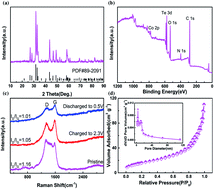In situ growth of metal–organic framework-derived CoTe2 nanoparticles@nitrogen-doped porous carbon polyhedral composites as novel cathodes for rechargeable aluminum-ion batteries†
Abstract
Rechargeable aluminum-ion batteries (AIBs) have attracted widespread attention due to their high theoretical capacity, abundant aluminum resources, high safety and low cost. Nevertheless, high-capacity, long-life cathode materials are still the most fundamental pursuit of studying AIBs. In this work, we have successfully synthesized a porous crystalline zeolitic imidazolate framework (ZIF) with specific morphology and uniform size. More importantly, ZIF-67 nanocrystals can be treated as precursors to acquire CoTe2 nanoparticles@nitrogen-doped porous carbon polyhedral composites (CoTe2@N-PC) through simple and rapid carbonization/tellurization treatment. Moreover, in situ grown CoTe2@N-PC can well maintain the porous structure and rhombic dodecahedral morphology of the precursor. Simultaneously, the carbon matrix converted from organic ligands in ZIF-67 with abundant mesopores and large surface area can provide a large electrochemically active surface and convenient charge/mass transport. The doping of heteroatoms such as nitrogen and oxygen has been demonstrated to optimize the electronic structure and enhance conductivity. As a result, when employed as the cathode material for AIBs with an ionic liquid electrolyte of AlCl3/[EMIm]Cl, CoTe2@N-PC can deliver an ultrahigh reversible initial capacity of 635.8 mA h g−1 at a current density of 200 mA g−1 even at high discharge cut-off voltages (voltage window: 0.5–2.3 V). After 200 cycles, the discharge specific capacity is still as high as 168.6 mA h g−1 and the Coulombic efficiency of the whole cycle exceeds 90%. Furthermore, an obvious discharge voltage plateau of about 1.4 V appears at various current densities. In summary, this work will broaden the synthesis of telluride nanoparticles with controlled morphology under low-cost and non-toxic conditions and provide a theoretical and experimental basis for the application of MOF-derived functional materials in AIBs and other related secondary batteries.



 Please wait while we load your content...
Please wait while we load your content...